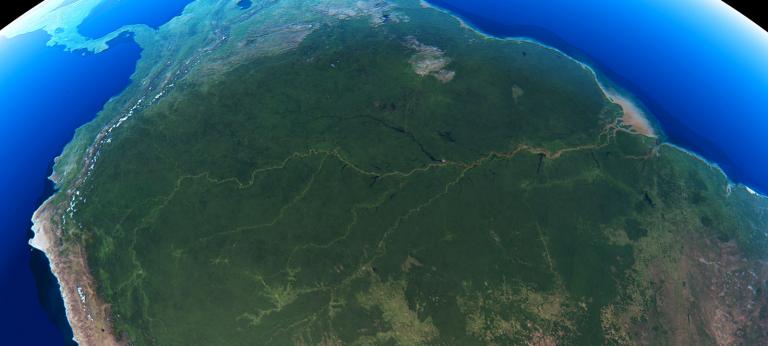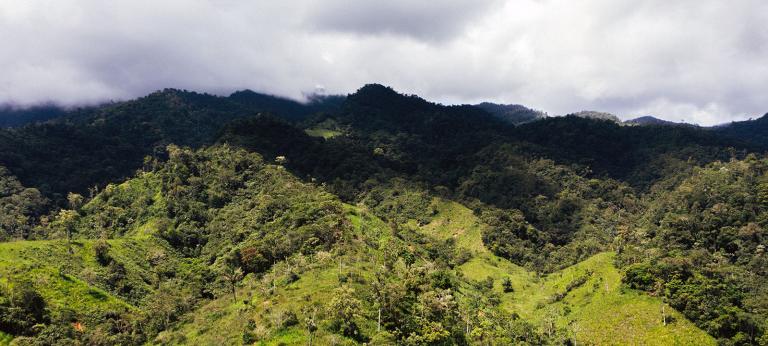&
&
Mitigation
The context
Forests are crucial for reducing greenhouse gas emissions and enhancing climate change adaptation. Healthy forests are more resilient to climate impacts. However, forest cover loss continues rapidly, contributing approximately 13 per cent of annual global net carbon emissions, mostly related to tropical deforestation and unsustainable forest management.
Financing forest conservation and restoration is difficult because many forest benefits are not monetized. Financial incentives of activities that drive deforestation often outweigh the incentives for conservation and restoration. In addition, unclear governance of forested lands leads to conflicts or lack of law enforcement to prevent deforestation.
Achieving the goals of the Paris Agreement relies strongly on ending forest destruction and enhancing forest and land carbon sinks. Extensive natural forested areas, with the Amazon being the largest, have important impacts on global weather patterns by acting as vast cooling systems. Forests enhance the climate resilience of people who live in and around them, including indigenous communities.
GCF's unique role
The Green Climate Fund (GCF) is the world’s largest dedicated fund helping developing countries reduce their greenhouse gas emissions and enhance their ability to respond to climate change in line with the Paris Agreement. GCF invests across four transition areas: the built environment; energy and industry; human security, livelihoods and wellbeing; and land-use, forests and ecosystems.
The GCF will contribute to shift the paradigm in the forest and land use sector through:
Forest Protection – Countries recognising the role of forests for mitigation and adaptation in their NDCs need to reflect this pathway in strategic planning instruments at national and local levels.
Forest Restoration – Restoring forested landscapes relies on international and national catalysts for reforestation, and on traditional and indigenous communities buy-in and leadership.
Sustainable Forest Management – Improved forests and forestry management can help to increase carbon sequestration and storage, and to grow resilience, while maintaining economic productivity.
These interventions require horizontal and vertical coordination between sectors, improving implementation of conservation, restoration, sustainable management of forests, sustainable agricultural practices, and other compatible land uses. Many deforestation drivers are linked to private activity, especially agriculture and timber.
GCF is uniquely placed to realise the potential of the Warsaw Framework for REDD+, reducing emissions from deforestation and forest degradation through GCF financial support for results-based payments (see case study). REDD+ can act as a viable form of funding for developing countries as alternatives to the economic benefits of forest clearing. Our direct financing of forest projects demonstrates many other innovative ways for more effective land management and establishing livelihood alternatives for people living in and around forests, including many Indigenous Peoples.
GCF continues to expand its forestry sector investments, particularly in Latin America, Africa and South-East Asia. In each of these regions, GCF achieves results by:
- Supporting transformational planning and programming. This includes the development of long-term sustainable forest management programmes with the involvement of the private sector, and the expansion of REDD+ results-based payments;
- Catalysing climate innovation through innovative business models and employing high-impact innovative technologies;
- Mobilising funds at scale through de-risking investments, and unlocking local capital with private sector investments in forest restoration; and
- Sharing knowledge of successful innovations and funding mobilisation efforts at scale and developing climate expertise of financial institutions to replicate them. This can include enabling the adoption of best practices for sustainable forest management, with the involvement of local indigenous peoples; and the involvement of the private sector in forest protection and restoration efforts.
GCF’s investments are anchored in our core principle of country ownership and are aligned with existing national planning processes (e.g. Nationally Determined Contributions (NDCs), Technology Need Assessments (TNAs) and National Adaptation Plans (NAPs). GCF supports countries through its Readiness programme by providing grants to help countries develop bankable investment plans based upon their NDCs. GCF leverages its range of financing instruments (grants, concessional loans, guarantee funds, equity investment) to meet country-specific needs and reduce risks for investors.
Partnerships have formed the basis of GCF’s business model since it was established. GCF investments can leverage and scale up existing sectoral initiatives, coalitions and platforms when planning interventions, creating multiplier effects at scale and promoting joint learning and knowledge transfer within the Forests and Land Use sector.
Resources

Thematic brief: Forests and land use
27 May 2021
Forests are crucial for reducing greenhouse gas emissions and enhancing climate change adaptation. Healthy forests are more resilient to climate impacts. However, forest cover loss continues rapidly, contributing approximately 13 per cent of annual global net carbon emissions, mostly related to tropical deforestation and unsustainable forest management.

SAP Technical Guidelines: Agriculture and food security
21 Feb 2023
This publication provides technical guidance for the preparation of SAP proposals. The agriculture thematic area encompasses agricultural production, land-use change caused by agricultural production and the food system in general. Agricultural production covers crop production and livestock. In addition to agricultural production the food system includes all steps from “farm to fork”: post-harvest handling, storage, manufacturing, processing, transport, retailing, consumption and food loss and waste at all levels across the supply chain.

SAP Technical Guidelines: Forests and land use
21 Feb 2023
This publication provides technical guidance for the preparation of SAP proposals. The thematic area of forest and land use encompasses forests and other multiple land-cover types where forests are a prominent component of the landscape. This can range from natural forests, where ecosystems are not directly impacted by human activities (e.g. primary forests) to more intensively transformed landscapes – such as secondary growth forests, degraded forest landscapes, agroforestry systems and trees outside forests, sustainably managed forests and forestry plantations.
Case studies

Bhutan for Life protects forest cover
GCF has joined the World Wildlife Fund (WWF), the Royal Government of Bhutan and other partners in financing the Bhutan for Life programme. This innovative financial structure helps Bhutan’s goal to keep 60 per cent of its area under forest cover through a network of forested Protected Areas. The funding is initially capitalised with a USD 43 million transition fund by donors, including GCF, combined with a contribution of USD 75 million by Bhutan’s government over 14 years from 2018. This programme is helping Bhutan remain “carbon negative,” as its forests sequester four times more than its annual emissions. See project details >

Managing forests and peatlands sustainably in Peru
In the Amazon basin, GCF is working with Peru’s Trust Fund for National Parks and Protected Areas (Profonanpe) to reduce deforestation and peatland degradation. GCF’s first project, approved in 2015, is assisting Peru’s Indigenous communities manage forests, peatlands and other wetlands in the country’s northern province of Datem del Marañón sustainably, notably by introducing sustainable harvesting and post-harvest processing of aguaje fruit, a major source of livelihoods. See project details >

Results-based payments for forest governance in Indonesia
This project recognises Indonesia's REDD+ results for 2014- 2016, with a total volume of 27 million tonnes of carbon dioxide equivalent (MtCO2eq) submitted to GCF for results- based payments (RBP). Indonesia uses these results-based payments to invest in activities that support the implementation of the country’s national REDD+ action strategy and address better forest governance. Key forest agencies at the national, provincial, and local levels are strengthened for better coordination. More decentralised sustainable forest governance is being implemented by establishing forest management units and expanding Indonesia’s social forestry programme. See project details >

ARBARO – the Sustainable Forestry Fund (multiple countries)
The ARBARO Programme will provide effective climate change mitigation outcomes through a private sector approach. This centres around investing in sustainable plantation projects in the emerging forestry markets of Latin America and Sub-Saharan Africa, while also bringing adaptation co-benefits to local communities. This investment approach provides developing countries and their rural populations with a solution to increase carbon sinks by producing wood in a sustainable manner and conserving natural forests, whilst contributing to the reduction of illegal logging. This will protect natural forests in project areas, and provide alternative wood resources. See project details >































